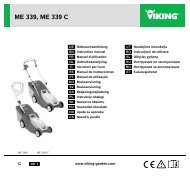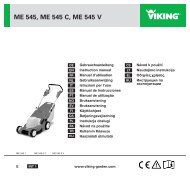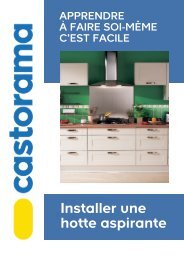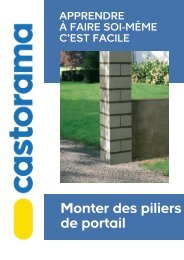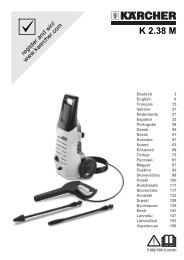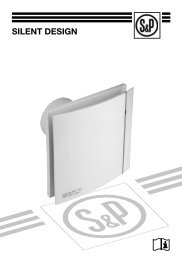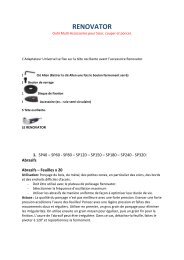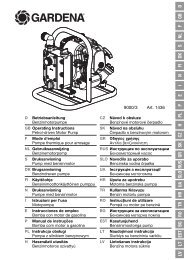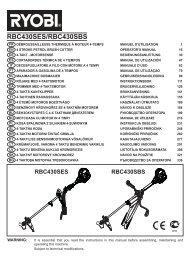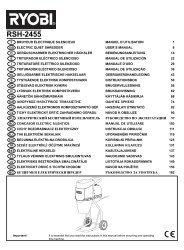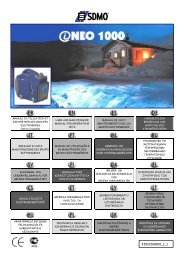You also want an ePaper? Increase the reach of your titles
YUMPU automatically turns print PDFs into web optimized ePapers that Google loves.
BDAL 6906_116306906 05.08.13 17:32 Seite 41<br />
t<br />
GENERAL SAFETY INSTRUCTIONS<br />
• Keep your workplace clean and well lit. Poor housekeeping or unlit working areas may result in accidents.<br />
• Do not work with power tools in an explosive ambience, where flammable liquids are kept and where gas or dust occur. Power tools will generate<br />
sparks which might ignite the dust or vapours.<br />
• Keep children and other persons off your workplace, while using power tools. When getting distracted you can lose the control over the<br />
equipment.<br />
• The plug of the power tool must fit into the socket. The plug must not be tampered with. Do not use adapters together with grounded power<br />
tools. Unmodified plugs and matching sockets will reduce the risk of getting an electric shock.<br />
• Keep power tools out of the rain and away from wetness. Water penetrating into a power tool will heighten the risk of getting an electric shock.<br />
• When working with a power tool outside, use only extension cords that are suitable for outdoor use. Using an extension cord that is suitable for<br />
outdoor use will reduce the risk of getting an electric shock.<br />
• If it is unavoidable to use a power tool in a wet ambience, use a residual-current circuit-breaker. It will reduce the risk of getting an electric shock.<br />
• Take care of what you do and handle the power tool with care. Never use a power tool, when you feel tired or when you are under the influence<br />
of drugs of any kind or alcohol. One moment of inat-tentiveness while using the power tool can cause severe injuries.<br />
• Do wear suitable personal protective clothing and equipment, such as hearing protection, goggles, dust masks while doing dust-generating jobs<br />
as well as protective gloves, when processing rough materials and when changing tools.<br />
• Remove the setting tools or wrenches before switching on the power tool. A tool or wrench at-tached to a rotating part of the equipment may<br />
cause injuries.<br />
• Wear suitable clothes, i.e. no loose garments or jewellery. Keep your hair, clothing and gloves away from rotating parts. Loose garments, jewellery<br />
or long hair may be caught by such rotating parts.<br />
• Always use the protective hood with the dust extractor.<br />
• Do not use power tools with a defective switch. A power tool that can no longer be switched on or off is dangerous and needs repairing.<br />
• Keep unused power tools out of the reach of children. Do not allow persons using equipment which they are not familiar with it, or persons who<br />
have not read these instructions. Power tools pose a danger, when being used by inexperienced persons.<br />
• Check before starting to work, whether equipment and tools function properly. Never work with damaged or blunt tools.<br />
• Have your power tools only repaired by duly qualified personnel. Demand original spares, so that the safety of the power tool remains ensured.<br />
• Pull the plug from the socket and/or remove the battery pack from the power tools before you change the setting of your equipment or before<br />
you replace any components. The unin-tentional re-start of a power tool may cause accidents.<br />
• Put up the machine table properly before installing the power tool. The table’s safe assem-bly is vital to prevent it from collapsing.<br />
• Attach the power tool safely to the machine plate before using it. If the power tool gets out of place on the machine plate, you may lose control<br />
of it.<br />
• Put the machine table on a firm, plain and horizontal surface. If the machine table can shift or wobble, neither the power tool nor the work piece<br />
can be moved safely and steadily.<br />
• Do not overload the machine table and do not use it as ladder or scaffolding. Excess loads or standing on the machine table can shift the table’s<br />
centre of gravity upwards, so that it may topple over.<br />
• Do not process any other materials than wood or easily machinable plastic. Exception: It is also allowed processing easily machinable metals<br />
(e.g. aluminium), but only with the jig-saw and a suitable saw blade<br />
• Loose splinters, chips or similar residues must not be removed by hand from the area close to the running saw blade!<br />
• The machines used must conform to DIN EN 60745-1. Equipment built after 1994 must bear the CE sign.<br />
• Do not merely saw by hand without a guiding aid; use the parallel or the angle guide.<br />
• Saw blades must not be slowed down by pushing from the side after the drive has been deactivated!<br />
• Use the tools for their intended purpose only.<br />
• Use only faultless saw blades; the base body must not be thicker and the width of the set of teeth not narrower than the thickness<br />
of the splitting wedge.<br />
• Make regular checks, whether all screws are tightened firmly!<br />
• Never use your workbench in an improper way or for purposes other than intended!<br />
• Remove all objects from the workbench that are not required.<br />
• Do not use the machine for cutting firewood.<br />
• Do not use the machine table for cutting log wood.<br />
• The power tools must only be switched on and off via the safety switch.<br />
• Use only the switch clamp supplied to permanently fix the appliance switch in the „ON“ position.<br />
• Always use a push stick when processing small or narrow work pieces.<br />
• When not in use, hang the push stick on the bracket provided (Fig. 8).<br />
• Make sure that the two swivelling brackets for securing the table legs are seated correctly with the safety bolts inserted in the holes in the side<br />
section and that the knurled screws are firmly tightened (Fig. 15.3).<br />
• Before starting work, make sure that the hand-held circular saw, router or jigsaw is properly attached to the machine plate, the machine plate<br />
is safely arrested in the notch on the machine table and the Allen wrench is inserted for additional safety (Fig. 17.3).<br />
• Do not use the machine outdoors in the rain.<br />
• Observe the maximum permitted workpiece dimensions (see Technical data).<br />
SAFETY INSTRUCTIONS FOR CIRCULAR SAWS<br />
• Apart from these machine-specific safety instructions, do also observe the safety instruc-tions for the hand-held circular saw you work with.<br />
• Only use hand-held circular saws with splitting wedge, with a maximum saw blade diame-ter of 200 mm and a maximum cutting depth of 70 mm.<br />
• Use only saws within the above maximum dimensions for the base plate (see Fig. 18).<br />
• Use the circular saw bench only, when the protective hood is properly fixed.<br />
• CAUTION: Make sure that the saw blade has been installed parallel to the opening in the saw gap and realign the hand-held circular saw, if<br />
necessary.<br />
• Support long work pieces at the removal side, so that they rest in a horizontal position; e.g. with a wolfcraft roller trestle (Art. No. 6119973).<br />
• Avoid overloading the hand-held circular saw.<br />
• Do not use grinding pads.<br />
• Use only recommended brands of saw blades and select them depending on the material to be sawn.<br />
• DANGER: Keep your hands off the sawing area and the saw blade.<br />
• Never reach under the work piece. The protective hood cannot protect you from the saw blade underneath the work piece.<br />
• Adapt the cutting depth to the thickness of the work piece; less than a full tooth height should be visible under the work piece.<br />
• Be always aware that the work piece can be caught by the running saw blade and hit the operator.<br />
• A back stroke is the result of using the saw incorrectly and/or for a wrong application. It can be prevented by suitable precautionary measures,<br />
as described below.<br />
41



